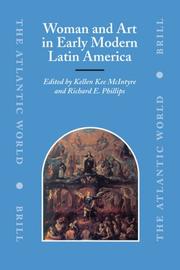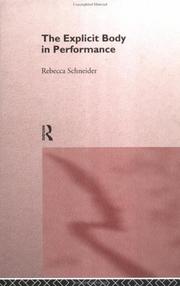| Listing 1 - 10 of 95 | << page >> |
Sort by
|
Periodical
ISSN: 25383116 25383108 Year: 1395 Publisher: Tihrān : Dānishgāh-i Tihrān,
Abstract | Keywords | Export | Availability | Bookmark
 Loading...
Loading...Choose an application
- Reference Manager
- EndNote
- RefWorks (Direct export to RefWorks)
Women --- Women in art --- Iran --- Civilization
Book
ISBN: 1283953293 1780422008 9781780422008 9781283953290 Year: 2009 Publisher: London : Sirrocco,
Abstract | Keywords | Export | Availability | Bookmark
 Loading...
Loading...Choose an application
- Reference Manager
- EndNote
- RefWorks (Direct export to RefWorks)
During the Renaissance, Italian painters would traditionally depict the wives of their patrons as Madonnas, often rendering them more beautiful than they actually were. Over centuries in religious paintings, the Madonna has been presented as the clement and protective mother of God. However, with the passing of time, Mary gradually lost some of her spiritual characteristics and became more mortal and accessible to human sentiments. Virgin Portraits illuminates this evolution and contains impressive works by Michelangelo, Caravaggio, Rubens, Fouquet, Dalí, and Kahlo.
Mary, --- Christian Women --- Women In Art --- Religion --- Art
Book
ISBN: 9789004379572 9004379576 9004395822 9789004395824 Year: 2019 Publisher: Leiden Boston BRILL
Abstract | Keywords | Export | Availability | Bookmark
 Loading...
Loading...Choose an application
- Reference Manager
- EndNote
- RefWorks (Direct export to RefWorks)
"In The Representations of Women in the Middle Kingdom Tombs of Officials Lubica Hudáková offers an in-depth analysis of female iconography in the decorative programme of Middle Kingdom non-royal tombs, highlighting changes and innovations in comparison to the Old Kingdom. Previously considered too uniform, the study represents the first systematic investigation of two-dimensional images of women and reveals their variability in space and time. Hudáková examines the roles appointed to women by analyzing how they are depicted in a variety of contexts. Taking into account their postures, gestures, garments, hairstyles, size of the body, age as well as attributes and tools used by them, along with the scene orientation, she traces diachronic and diatopic developments and regional traditions in the Middle Kingdom tomb decoration"--
Tombs --- Women in art --- Women --- Human females --- Wimmin --- Woman --- Womon --- Womyn --- Females --- Human beings --- Femininity --- Decoration&delete& --- History --- Egypt --- Women in art. --- Decoration --- History.

ISBN: 9004153926 9786611400613 1281400610 9047410998 9789047410997 9789047410997 9789004153929 Year: 2007 Publisher: Leiden Boston Brill
Abstract | Keywords | Export | Availability | Bookmark
 Loading...
Loading...Choose an application
- Reference Manager
- EndNote
- RefWorks (Direct export to RefWorks)
This anthology centers on the visual representation of woman in early modern Latin America, that is, the social and cultural construction and definition of female identity as evidenced by the art document. Artists in this period were collectively aware of a vocabulary of gender that could be tailored to deliver varying messages about the position of women in vice regal culture and society. This volume is organized not in the predictable linear framework, by periods and centuries, but rather by the realization that throughout much of this period, Spanish authorities and others envisaged the Spanish colonies of the Americas in gendered terms. Proffered as the female body, the “New” (virginal by implication) World was at differing times adored, pursued, courted, seduced, defiled, exploited, reviled, and denounced by those (males) who encountered “her.” This mentality is born out in the various forms of female representation that are discussed in this fully illustrated book. Contributors include: C. Cody Barteet, María Elena Bernal-García, Magali M. Carrera, Carol E. Damian, Carolyn Dean, Catherine R. DiCesare, Lori Boornazian Diel, Kelly Donahue-Wallace, Ray Hernandez-Duran, Andrea Lepage, Kellen Kee McIntyre, Penny Morrill, Elizabeth Q. Perry, Richard E. Phillips, Michael J. Schreffler, and Christopher C. Wilson. ERRATUM TO CHAPTER 7 Ray Hernández-Durán, “ El Encuentro de Cortés y Moctezuma : The Betrothal of Two Worlds in Eighteenth-Century New Spain” (pp. 181–206). On page 194, second paragraph, third sentence, should read: “Marina’s absence in the encounter painting, where she normally mediates contact between the men, emphasizes the phallogocentric aspect of the historic meeting.” The original phrasing, using the pivotal term, ‘phallogocentric’ (a reference to a gendered form of exchange or communication) was changed to ‘phallus-centered,’ which not only alters a central idea in the argument, but actually has nothing to do with the image in question.
Women in art. --- Art, Latin American --- Art, Spanish American --- Latin American art --- Spanish influences.
Book
ISBN: 9789004540774 9004540776 9004540784 9789004540781 Year: 2023 Publisher: Leiden, The Netherlands : Brill,
Abstract | Keywords | Export | Availability | Bookmark
 Loading...
Loading...Choose an application
- Reference Manager
- EndNote
- RefWorks (Direct export to RefWorks)
The first comprehensive study of the importance of fecunditas (human fertility) in Roman society, c. 100 BC - AD 300, this book makes a major contribution to our understanding of the connections between fertility, the Roman family, and the Roman state.
Human reproduction --- Family size --- Families --- Women --- Social aspects --- Rome --- Population policy. --- Women in art
Book
ISBN: 9780567674609 9780567674616 9780567685162 0567685160 0567674606 9780567674623 0567674622 0567674614 Year: 2018 Publisher: London
Abstract | Keywords | Export | Availability | Bookmark
 Loading...
Loading...Choose an application
- Reference Manager
- EndNote
- RefWorks (Direct export to RefWorks)
"In this guest-edited issue of Biblical Reception, edited by Diane Apostolos-Cappadona, contributors examine the reception of the bible in art. Most of the contributions focus on biblical women, or on encounters with women in the bible. The volume is roughly chronological in structure, beginning with two pieces on Eve, one of which compares representations of Eve with those of the Virgin Mary, the other which considers how Eve is presented in Islamic texts and images. Following a contribution on Esther and Sarah the volume moves on to consider New Testament texts, with notable focus on women at the peripheries of society (the woman with the hemorrhage in Mark's gospel and the woman of Samaria). Attention is also paid to representations of Mary Magdalene and of Judith and Salome. The volume concludes with a piece on apocalyptic imagery and the woman clothed with the sun of Revelation 12. Featuring over 50 high quality color images, this volume provides scholarship of the highest level on biblical art." --Bloomsburg Publishing In this guest-edited issue of Biblical Reception, edited by Diane Apostolos-Cappadona, contributors examine the reception of the bible in art. Most of the contributions focus on biblical women, or on encounters with women in the bible. The volume is roughly chronological in structure, beginning with two pieces on Eve, one of which compares representations of Eve with those of the Virgin Mary, the other which considers how Eve is presented in Islamic texts and images. Following a contribution on Esther and Sarah the volume moves on to consider New Testament texts, with notable focus on women at the peripheries of society (the woman with the hemorrhage in Mark's gospel and the woman of Samaria). Attention is also paid to representations of Mary Magdalene and of Judith and Salome. The volume concludes with a piece on apocalyptic imagery and the woman clothed with the sun of Revelation 12. Featuring over 50 high quality color images, this volume provides scholarship of the highest level on biblical art
Art --- iconography --- Bibles --- women [female humans] --- Personnages bibliques --- Women in art. --- Women in the Bible. --- Bible
Book
ISBN: 9048555507 9463723579 9789048555505 Year: 2023 Publisher: Amsterdam
Abstract | Keywords | Export | Availability | Bookmark
 Loading...
Loading...Choose an application
- Reference Manager
- EndNote
- RefWorks (Direct export to RefWorks)
The motif of the woman and the dragon has been prevalent in Western art since antiquity, yet has hitherto remained understudied, and artworks featuring this motif in Western Mediterranean cultures have been examined primarily in relation to the topos of the male dragon-slayer. This book analyzes artistic images of women and dragons over an extensive period, from Classical Greece and Rome (with forays to Egypt and Mesopotamia) to the early modern period in Western Europe. The unique methodology employed in the study of this motif reveals its sacred core, as well as its relationship to rituals of fertility and oracular knowledge, to the liminal realm between life and death, and to the symbolism of Great Mother goddesses. At the same time, the images explored throughout expose stereotypes and biases against women in unusual positions of power, which were embedded in the motif and persisted in Western European art.
Women in art. --- Women, Dragon, Art, Witch, Sacred. --- Dragons in art.
Book
ISBN: 9783846743911 9783770543915 3846743917 Year: 2007 Publisher: Paderborn : Wilhelm Fink Verlag,
Abstract | Keywords | Export | Availability | Bookmark
 Loading...
Loading...Choose an application
- Reference Manager
- EndNote
- RefWorks (Direct export to RefWorks)
Medizinische Bilder haben einen hohen Anteil an der Formierung von Wissen über den weiblichen Körper, indem sie dessen Be-trachtungsweisen organisieren und maßgebliche Prototypen gestalten. Diese Prototypen drücken sich in zwei Konstrukten des Frauenkör-pers aus. Zum einen durch die Imagination des weiblichen Kör-pers als jugendliche, makellose Oberfläche - somit als HÜLLE -, und zum anderen durch die Vor-stellung als potenziell mütterli-cher Körper und Behälter für den Fötus - und somit als CONTAINER. Im Internet existieren äußerst heterogene Bilder der Repräsen-tation und Konstruktion von Weiblichkeit. Dem begegnet die vorliegende Publikation, indem sie eine Ikonologie von medizini-schen Weiblichkeitsmodellen erstellt. Auf der Basis von breit angelegten Net-Scans werden exemplarische Schlüsselbilder der HÜLLE und des CONTAINERS untersucht, die medizinische Bildstrategien in unterschiedli-chen historischen und medialen Bildsorten präsentieren.
Medical illustration. --- Women in mass media. --- Women in art. --- Internet in medicine. --- Internet and women.
Book
ISBN: 3890854001 Year: 1993 Publisher: Pfaffenweiler Centaurus
Abstract | Keywords | Export | Availability | Bookmark
 Loading...
Loading...Choose an application
- Reference Manager
- EndNote
- RefWorks (Direct export to RefWorks)
Women artists --- -Women in art --- -Feminist theory --- -Feminism --- Feminist philosophy --- Feminist sociology --- Theory of feminism --- Feminism --- Artists, Women --- Women as artists --- Artists --- Bibliography --- Philosophy --- -Bibliography --- Feminist theory --- Women in art

ISBN: 0415090261 0415090253 1280321598 0203421078 1134876939 1134876920 0203305981 9780203305980 9780203421079 9780415090261 6610321590 9786610321599 9781134876938 9781134876884 1134876882 9781134876921 9780415090254 Year: 1997 Publisher: London New York Routledge
Abstract | Keywords | Export | Availability | Bookmark
 Loading...
Loading...Choose an application
- Reference Manager
- EndNote
- RefWorks (Direct export to RefWorks)
The Explicit Body in Performance interrogates the avant-garde precedents and theoretical terrain that combined to produce feminist performance art. Among the many artists discussed are: * Carolle Schneemann * Annie Sprinkle * Karen Finley * Robbie McCauley * Ana Mendieta * Ann Magnuson * Sandra Bernhard * Spiderwoman Rebecca Schneider tackles topics ranging across the 'post-porn modernist movement', New Right censorship, commodity fetishism, perspectival vision, and primitivism. Employing diverse critical theories from Benjamin to Lacan to postcolon
Arts, Modern --- Feminism and the arts. --- Performance art. --- Women artists --- Women in art. --- Psychology. --- Arts and feminism --- Theatrical science --- anno 1900-1999 --- Feminism and the arts --- Performance art --- Women in art --- Happenings (Art) --- Performing arts --- Arts --- Psychology
| Listing 1 - 10 of 95 | << page >> |
Sort by
|

 Search
Search Feedback
Feedback About UniCat
About UniCat  Help
Help News
News